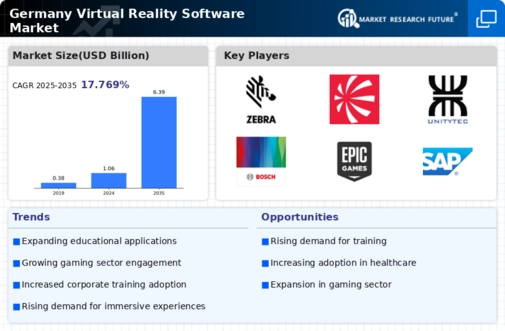The Germany Virtual Reality Software Market is characterized by a dynamic competitive landscape, fueled by rapid technological advancements and an increasing demand for immersive experiences across various industries such as healthcare, manufacturing, education, and entertainment. This market is witnessing the entry of numerous players who are innovating and providing cutting-edge solutions, emphasizing the importance of scalability, user experience, and integration with existing systems.
As more businesses recognize the potential of virtual reality to enhance training, improve product design, and engage customers, the competition is intensifying. Firms are also focusing on establishing strategic partnerships and collaborations to leverage shared expertise, expand their market reach, and drive growth in this evolving sector.Siemens AG stands out in the Germany Virtual Reality Software Market with its robust technological capabilities and extensive industry expertise.
The company has successfully integrated virtual reality solutions into its portfolio, offering tools that assist in product development, simulation, and training processes. Siemens AG’s strengths lie in its established reputation in the industrial sector, allowing it to leverage its existing customer base and relationships. Furthermore, its commitment to research and development ensures continuous innovation, positioning Siemens AG as a leader in creating realistic VR environments that are beneficial for a range of applications.
The company’s localized approach in Germany enables it to cater specifically to the unique needs of the domestic market while enhancing user engagement through tailored experiences.Zebra Technologies has also made a notable impact in the Germany Virtual Reality Software Market, focusing on providing real-time visibility solutions that enhance operational efficiency.
The company is recognized for its advancements in augmented reality and virtual reality applications, which support various industries such as logistics, retail, and manufacturing. Zebra Technologies stands out for its flagship products that integrate VR capabilities with analytics and automation software, delivering seamless solutions to its customers.
The company’s strength lies in its ability to deliver tailored experiences through a deep understanding of customer needs in the German market. Moreover, strategic mergers and acquisitions have enabled Zebra Technologies to broaden its technology offerings and expand its market presence. Through its innovative approach and commitment to quality, Zebra Technologies continues to strengthen its position in Germany’s virtual reality landscape.





















Leave a Comment